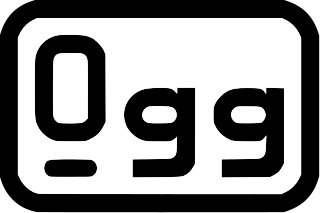
Ogg is a free, open container format maintained by the Xiph.Org Foundation. The authors of the Ogg format state that it is unrestricted by software patents and is designed to provide for efficient streaming and manipulation of high-quality digital multimedia. Its name is derived from "ogging", jargon from the computer game Netrek.

RSS is a web feed that allows users and applications to access updates to websites in a standardized, computer-readable format. Subscribing to RSS feeds can allow a user to keep track of many different websites in a single news aggregator, which constantly monitor sites for new content, removing the need for the user to manually check them. News aggregators can be built into a browser, installed on a desktop computer, or installed on a mobile device.

RSSOwl is a discontinued news aggregator for RSS and Atom news feeds. It is written in Java and built on the Eclipse Rich Client Platform which uses SWT as a widget toolkit to allow it to fit in with the look and feel of different operating systems while remaining cross-platform. Released under the EPL-1.0 license, RSSOwl is free software.

The name Atom applies to a pair of related Web standards. The Atom Syndication Format is an XML language used for web feeds, while the Atom Publishing Protocol is a simple HTTP-based protocol for creating and updating web resources.
Web standards are the formal, non-proprietary standards and other technical specifications that define and describe aspects of the World Wide Web. In recent years, the term has been more frequently associated with the trend of endorsing a set of standardized best practices for building web sites, and a philosophy of web design and development that includes those methods.

On the World Wide Web, a web feed is a data format used for providing users with frequently updated content. Content distributors syndicate a web feed, thereby allowing users to subscribe a channel to it by adding the feed resource address to a news aggregator client. Users typically subscribe to a feed by manually entering the URL of a feed or clicking a link in a web browser or by dragging the link from the web browser to the aggregator, thus "RSS and Atom files provide news updates from a website in a simple form for your computer."
A podcast is a program made available in digital format for download over the Internet. For example, an episodic series of digital audio files that users can download to a personal device to listen to at a time of their choosing. Podcasts are primarily an audio medium, but some distribute video, either as their primary content or as a supplement to audio.
3GP is a multimedia container format defined by the Third Generation Partnership Project (3GPP) for 3G UMTS multimedia services. It is used on 3G mobile phones but can also be played on some 2G and 4G phones.
OpenSearch is a collection of technologies that allow the publishing of search results in a format suitable for syndication and aggregation. Introduced in 2005, it is a way for websites and search engines to publish search results in a standard and accessible format.
RSS enclosures are a way of attaching multimedia content to RSS feeds with the purpose of allowing that content to be prefetched. Enclosures provide the URL of a file associated with an entry, such as an MP3 file to a music recommendation or a photo to a diary entry. Unlike e-mail attachments, enclosures are merely hyperlinks to files. The actual file data is not embedded into the feed. Support and implementation among aggregators varies: if the software understands the specified file format, it may automatically download and display the content, otherwise provide a link to it or silently ignore it.
Microformats (μF) are a set of defined HTML classes created to serve as consistent and descriptive metadata about an element, designating it as representing a certain type of data. They allow software to process the information reliably by having set classes refer to a specific type of data rather than being arbitrary.

In computing, a news aggregator, also termed a feed aggregator, content aggregator, feed reader, news reader, or simply an aggregator, is client software or a web application that aggregates digital content such as online newspapers, blogs, podcasts, and video blogs (vlogs) in one location for easy viewing. The updates distributed may include journal tables of contents, podcasts, videos, and news items.
Podcasts, previously known as "audioblogs", have roots dating back to the 1980s. With the advent of broadband Internet access and portable digital audio playback devices such as the iPod, podcasting began to catch hold in late 2004. Today there are more than 115,000 English-language podcasts available on the Internet, and dozens of websites available for distribution at little or no cost to the producer or listener.
The RSS Advisory Board is a group founded in July 2003 that publishes the RSS 0.9, RSS 0.91 and RSS 2.0 specifications and helps developers create RSS applications.
RSS-TV is an XML-based navigation protocol for Internet media services based on the RSS standard.

MPEG-4 Part 14, or MP4, is a digital multimedia container format most commonly used to store video and audio, but it can also be used to store other data such as subtitles and still images. Like most modern container formats, it allows streaming over the Internet. The only filename extension for MPEG-4 Part 14 files as defined by the specification is .mp4. MPEG-4 Part 14 is a standard specified as a part of MPEG-4.
Web syndication technologies were preceded by metadata standards such as the Meta Content Framework (MCF) and the Resource Description Framework (RDF), as well as by 'push' specifications such as Channel Definition Format (CDF). Early web syndication standards included Information and Content Exchange (ICE) and RSS. More recent specifications include Atom and GData.

QuiteRSS is a free and open source cross-platform news aggregator for RSS and Atom news feeds. QuiteRSS is released under the GPL-3.0-or-later license. It is available for Microsoft Windows, MacOS, Linux, and OS/2. QuiteRSS is also available as a portable application for Windows.

RSS Guard is a free and open-source news aggregator for web feeds and podcasts. It is written in C++ and uses Qt, which allows it to fit with the look and feel of different operating systems while remaining cross-platform. It includes a file downloader, advanced network proxy configuration, and supports external media viewing tools.






